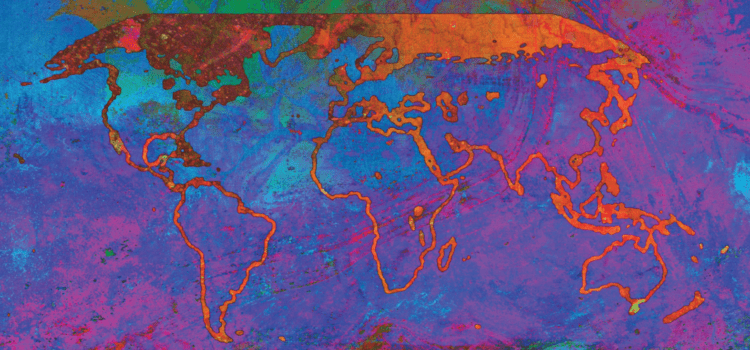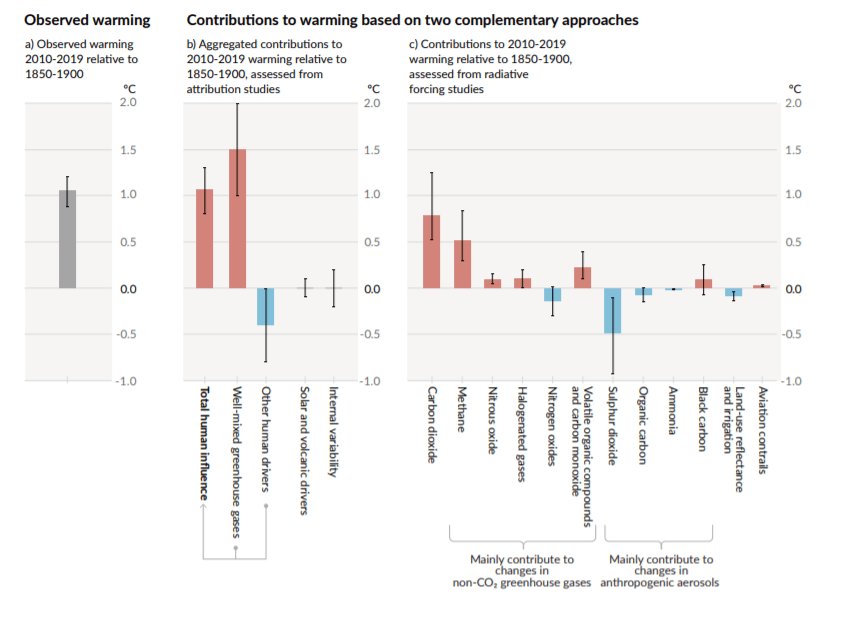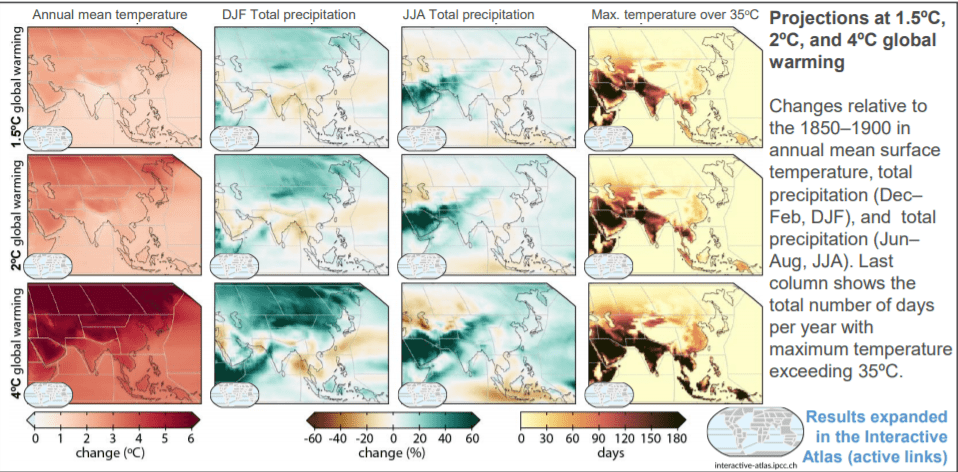Founded in 1988 by the World Meteorological Organization (WMO), in collaboration with the United Nations Environment Programme (UNEP), the Intergovernmental Panel on Climate Change (IPCC) currently comprises 195 member states. Contrary to popular belief, IPCC itself does not conduct research nor does it monitor climate change. The primary objective of IPCC is to evaluate all published literature on the subject to formulate a comprehensive overview on climate change, its impact on human society as well as strategies to mitigate it.
The Sixth Assessment Report (2021)
The Fifth Assessment Report, completed in 2014, formed the basis of the Paris Climate Agreement. The Sixth Assessment Report, published on 9th August, 2021, was succinctly summarized by the British newspaper The Guardian as ‘the starkest warning yet’ of ‘major and inevitable climate changes’ – with similar sentiments echoing around the world.

While the report itself is 3000+ pages long, and therefore inaccessible (both due to the sheer length and knowledge gap in understanding a high level climate change report) to the common man, IPCC released two summaries: one for policymakers and a technical summary. They provide a concise explanation for our current understanding regarding climate change.
Main Conclusions
The main takeaway from the report, and the one that is argued about the most in popular media, is this: Human influence has, unequivocally, warmed the atmosphere, ocean and land. This has resulted in widespread and rapid changes in the biosphere at large, the scale of which is unprecedented over many centuries to thousands of years. The observed warming is primarily driven by human emissions of greenhouse gases, but is partially masked by aerosol cooling. Additionally, climate extremes caused by the warming are already affecting weather patterns across the globe, with increased prevalence of droughts, wildfires, excessive rains and so on.

Possible Climate Futures
Five illustrative climate futures are discussed in detail in the report. Greenhouse gases are abbreviated to GHG.
#1: Under all considered scenarios, global surface temperatures will continue to rise till mid-21st century
i. Under the very low GHG emissions scenario, the global temperatures are still expected to rise by 1.0°C to 1.8°C.
ii. In the intermediate GHG emissions scenario, global temperatures are expected to rise by 2.1°C to 3.5°C.
iii. In the very high GHG emissions scenario, they are expected to rise by 3.3°C to 5.7°C.
#2: Changes in the climate system become larger in direct relation to rising global warming
The report concludes, with plausible certainty, that with every additional increment of global warming, changes in extremes continue to be larger.
i. Land surfaces will continue to warm more than the oceans by a factor of 1.4 to 1.7. The Arctic will continue to warm more than the global surface, by a factor of 2. The Arctic is likely to become ice-free at least once in September by 2050. However, there is no expected decrease in Antarctic sea ice.
ii. According to projections for heavy precipitation events, for each 1°C of global warming, these events are expected to intensify by 7 %.
#3: Intensification of the global water cycle
i. Under the very low GHG emissions scenario, the average annual global land precipitation is projected to increase by 0 – 5%, 1.5 – 8% for the intermediate GHG emissions scenario and 1 – 13% for the very high GHG emissions scenario.
ii. Warmer climate will tend to intensify both very dry and very wet weather scenarios.
#4: Land and Carbon sinks will become less effective with increasing CO2 emissions
With increasing cumulative CO2 emissions, the proportion of emissions taken up by land and ocean will decrease, i.e, the effectiveness of natural sinks will decrease.
#5 These changes are irreversible for millenia to come
i. The IPCC report places high confidence in the conclusion that GHG emissions since 1750 have contributed significantly to the warming of oceans. Over the next eighty years, ocean warming will likely range from 2 – 4 to 4 – 8 times the range observed from 1971 – 2018. These changes will further impact deep ocean acidification and deoxygenation, both of which are irreversible on a centennial scale.
ii. Following permafrost thaw, loss of permafrost carbon is irreversible. During the 21st century, there will be continued loss of the Greenland Ice Sheet and likely loss of the Antarctic Ice Sheet.
iii. Global mean sea levels will continue to rise over the course of the century. By 2100, under the very low GHG emissions scenario, the sea level will rise by 0.28 – 0.55m. Under the intermediate emissions scenario, it will rise by 0.44 – 0.76m, and by 0.63 – 1.01m for the high emissions scenario.
iv. Sea levels will remain elevated for millenia due to continuing deep ocean warming and ice sheet melt.

Projections for Asia
The interactive atlas can be found here.
The topography of Asia is such that almost every kind of geographical feature is included within the continental boundaries. Thus the impact of climate change varies significantly from region to region within Asia.
For Asia at large, there are certain regional changes common to all. Heat extremes have risen, and cold extremes have fallen. Marine heatwaves will increase, along with average precipitation. As with most polar regions, glaciers will decline and permafrost will thaw. Compared to the global average, sea levels in Asia increase faster than anticipated.

South Asia (SAS)
i. Heatwaves and humid stress will both increase.
ii. Both annual and summer precipitation will rise during the course of the century.
South-East Asia (SEA)
i. While enough data is not available to establish a long-term trend, fewer but higher intensity cyclones have struck the region.
ii. Future warming is expected to be slightly less than the global mean.
iii. In the Mekong Delta, prolonged human activity will lead to higher flood levels.
East Asia (EAS, ECA)
i. With an increase in heavy precipitation, and their frequency, landslides in mountainous areas will also increase.
ii. Droughts will become more frequent and Eastern Central Asia will become wetter.
iii. Similar to SEA, tropical cyclones have increased in intensity.
Tibetan Plateau (TIB)
The Tibetan Plateau has extensive geopolitical importance due to the sheer volume of water available within the area.
i. Precipitation is expected to rise in the whole area spanning the Himalayas.
ii. While the Hindu Kush glaciers have lost mass, the Karakoram glaciers have remained in either a balanced state or have decreased.
South-West Asia (WCA, ARP)
i. While precipitation has increased in elevated areas, droughts are common in the low-lying region.
ii. Permafrost degradation increases instability of mountain slopes.
North Asia (WSB, ESB, RFE)
i. With further global warming, permafrost extent and volume will shrink.
ii. The number of dry days has decreased in most areas except the south-west where the fire season is expected to lengthen.
Concluding Remarks
The Secretary-General of the UN stated that the report was a code-red for humanity, a statement proved abundantly clear in the report itself. The current primary objective must be to cut methane emissions as quickly as possible, so that we may buy time for the CO2 emission cuts to take effect. The carbon budget is estimated to be around 500B tonnes of CO2 if we aim at keeping global temperatures below 1.5°C. This would mean attaining net zero emissions by 2050.
Perhaps for the first time ever, in the wake of natural disasters across the globe (North American heatwave, flooding in Europe, India and China and the continuing wildfire season), the impact of climate change has never been clearer. Scientific evidence simply corroborates this claim.
We must take strong, decisive steps and do so soon. The world is in a state of emergency, and we must do our part to ensure a safe, healthy planet for the next generation to live in.
Written by- Anusha Paul Choudhury
Edited by- Krish Sharma
